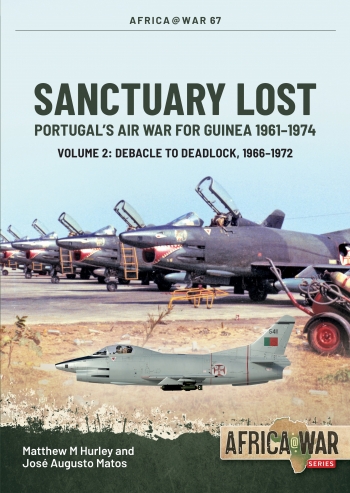
- aviationmegastore.com
- Ship to United States
Quick Search
Aviation Shop
categoriesPublic holidays
Amended or confirmed operating hours of the Luchtvaart Hobby Shop in Aalsmeerderbrug on the following dates:
Aviation Megastore website is available without limitations. Orders are processed during shop operating hours.
| Tu | 24 Dec. | Open 10-15 hrs |
| We | 25 Dec. | Closed: Christmas |
| Th | 26 Dec. | Closed: Christmas |
| Tu | 31 Dec. | Open 10-15 hrs |
| We | 1 Jan. | Closed: New Year's Day |
Sanctuary Lost Volume 2: Portugal's Air War for Guinea, 1961-1974. Debacle to Deadlock, 1966-1972
Product code 9781804512050
€ 24.72
Series Africa @ War 67
Publisher/Brand Helion & Company
Author Matthew M Hurley, José Augusto Matos
No. Pages 112
Version Soft cover
Language English
Category Books on aviation
Subcategory World Wars » War in Africa
Availability In stock
This product was added to our database on Thursday 1 february 2024.
Your reliable Aviation Book Source since 1989
Also in this series:
Product description
From 1963 to 1974, Portugal and its nationalist enemies fought an increasingly intense war for the independence of "Portuguese" Guinea, then a colony but now the Republic of Guinea-Bissau. For most of the conflict Portugal enjoyed virtually unchallenged air supremacy, and increasingly based its military strategy and political pacification programme on this singular advantage. The Portuguese Air Force (Força Aérea Portuguesa, abbreviated FAP) consequently played a crucial role in the Guinean war. Indeed, throughout the conflict, the FAP – despite the many challenges it faced – proved to be the most effective and responsive military argument against the PAIGC rebels, which was fighting for the colony's independence from European rule.
The air war for Guinea stands as a remarkable episode in air power history for several reasons. It was, for example, the first conflict in which a non-state irregular force deployed defensive missiles against an organised air force. Moreover, the degree to which Portugal relied on its air power was such that its effective neutralisation doomed Lisbon's military strategy in the province. Ultimately, the FAP's unexpected combat losses initiated a cascade of effects that degraded, in turn, its own operational initiative; the battlefield effectiveness of increasingly air-dependent ground forces; Portuguese military morale and national resilience; and ultimately, Lisbon's tenability as an imperial power. The air war for Portuguese Guinea thus represents a compelling illustration of the value – and vulnerabilities – of air power in a counter-insurgency context, as well as the negative impacts of overreliance on air supremacy.
This, the second of three volumes in the Sanctuary Lost mini-series, examines the evolution of Portuguese air power and guerrilla air defences during the conflict's most active years, as both sides sought the means and methods required to counter the other's efforts to control Guinea's airspace. It is richly illustrated throughout with original photographs and includes specially commissioned colour artworks.
Images : 84 b/w photos, 20 colour profiles, 24 b/w maps, 1 colour map, 5 diagrams, 20 tables, 7 graphs
Shopping cart
Your shopping cart is empty.
Login
- aviationshopsupplies.com
- aviationmegatrade.com
© 1989–2024 Luchtvaart Hobby Shop B.V.









